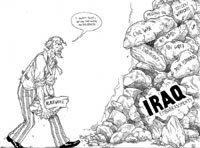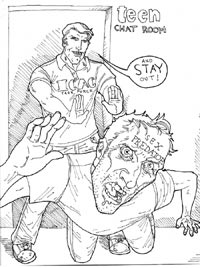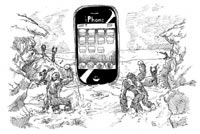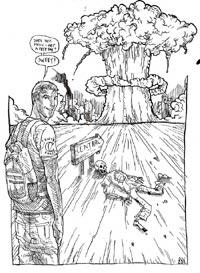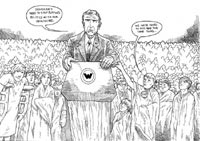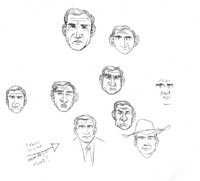This is the first in what I hope will be a regular series of profiles on young cartoonists. Whether they’re in high school or early in their college cartooning days (at least prior to winning the Charles Schultz award) I hope to take a day every two weeks or so to shine a spotlight on a cartoonist early in their career.
The inaugural cartoonist in this series is Bob Al-Greene, an 18-year-old freshman at the University of Nebraska – Lincoln. Bob is one of three cartoonists at the Daily Nebraskan, the UN-L student newspaper. He earned a ranking of Superior at the Spring 2006 National JEA/NSPA convention in San Francisco. He has also won a few awards from Quill and Scroll, the National Federation of Press Women and he was the Nebraska High School Journalist of the Year last year.
NEAL OBERMEYER: When did you get your start in editorial cartooning? What made you decide to start?
BOB AL-GREENE: I’ve been drawing my whole life, but I started doing cartoons during my sophomore year in high school for the school newspaper, the Central High Register. Central’s journalism department is one of the very best in the entire country, so I couldn’t have asked for a better opportunity, as far as turning my work in to competitions and things like that. My mom originally had urged me to start up a website and start putting up my cartoons, but I’m only getting around to that now.
The opportunity to express a clear and defined opinion solely through my art and a few choice words was, looking back, not something I was sure I could do, because I don’t consider my art to be in the same style as a lot of cartoonists, but it’s been working pretty well for me so far.
N: I would agree that your art is not in the same style as the “traditional” editorial cartoons – have you ever felt any pressure to conform – from yourself or others – or had people tell you “This isn’t what editorial cartoons are supposed to look like!”
B: I’ve tried a couple of times to simplify my drawings or stylize them even more, but instead my stuff just comes across looking childish, which is what I don’t want, so it doesn’t see print. I’m not sure I’ve found my artistic niche quite yet. I still have some evolving to do. I actually can’t remember anyone ever telling me, “This isn’t what editorial cartoons are supposed to look like!” or anything like that, and I’ll credit that to the fact that everyone has a different style and the truth is, cartoons are an extremely open genre and can be taken in any number of directions.
This summer a cartoonist was on “The News Hour” (one of my favorite programs to get ideas from) and he was talking about how cartoonists are having to make the switch to the Internet to keep their readership, and how they’re literally doing animated cartoons with voice-overs and impressions… That just turns the entire concept on its head. This is a very exciting time to be a young journalist.
N: You said earlier you were unsure that editorial cartooning was something you could do — what made you take that first step to apply to Central’s newspaper?
B: It’s a funny story, actually – I had already asked the journalism adviser once, in passing, if I could sign up, but the process was kind of complicated since I was in a class which would conflict with the journalism prerequisite class. But I happened to be in the same math class as Molly Mullen, who was at that point a junior staffer but would go on to become editor in chief for two years straight. Molly saw me drawing in class and asked if I wanted to do cartoons, then pretty much literally dragged me down to the journalism room so I could figure out how to beat the system and get into the class. So, not a lot of self-motivation on my part.
N: How much do you read editorial cartoons and how much have you read them in the past?
B: Whenever I open a paper, I’ll go straight to the op-ed/cartoon page every time. I’m not always looking for inspiration from the cartoons (usually just entertainment). I’ve bought books of the best political cartoons of the year when preparing for competitions, and looking at a ton of images at once sometimes clues you on to what is most effective or most eye-catching or emotionally powerful. This helps when I’m in a tight spot and need a good way to break down what the cartoon is saying and how it should be said.
N: Who are your biggest influences?
B: It would be impossible to say that seeing [Omaha World-Herald cartoonist] Jeff Koterba’s work day after day hasn’t had some effect on what I consider to be a good cartoon. I don’t always agree with the guy’s politics, but you can’t deny his skill. I got to meet him once, and the biggest piece of advice he gave me and which has stuck with me, is that a cartoonist can’t get by without reading constantly. If a cartoonist isn’t informed, or at the very least aware, then how is he or she going to turn out topical, insightful cartoons?
As far as my actual art, I’ve got to say I’m kind of a superhero geek, so I’ve read a lot of comic books and that’s where I get my style. It’s not that I’m drawing capes on the president or anything, but when I need to portray a heroic or sinister character, the influence of comics comes across pretty clearly.
N: Other than Koterba, are there any other cartoonists, for example, from the “Best cartoons of the year” books, that you remember being especially influential or exemplary?
B: Tom Tomorrow is without a doubt my favorite cartoonist around today. His sense of humor and politics are just so much like mine, and he’s so different that I didn’t even consider him when you first asked this question. No other cartoonist can make me so angry at the administration and make me laugh so hard at the same time.
Also, beyond a shadow of a doubt, the great (if weird) R. Crumb. He has a distinctive hatching and shadowing style which give his work a great appearance of texture. I don’t know how much I’ve tried to imitate him in my art, but I get the sense that if I ever actually drew a comic book, I would adopt a style very much like his. Some of his cityscapes or street scenes, which I am stupendously bad at rendering, are amazing.
If I was to really think about my influences, though, I would have to go back to comic books. For instance, Jack Kirby, who along with writer Stan Lee created icons such as the Hulk, the Fantastic Four and the X-Men. The raw kinetic energy and sense of motion in some of Kirby’s work is unmatched as far as I’m concerned.
Contemporary artists such as John Cassaday, Bryan Hitch (no relation to David) and Alex Ross have had serious impact on my work.
N: What is your process like? As far as developing your ideas, getting approval, execution, and so on?
B: My cartoons are due on Sunday nights, so I start thinking about what I’m going to draw on Sunday afternoon. No, I’m kidding. During the week I’ll keep an eye on the news, read the papers, and develop a mental checklist of the top stories, those I feel most strongly about or the students are likely to be familiar with. By Thursday I’ll have it narrowed down to two or three topics. Then (and this has been true so far), a completely different topic will pop up in my brain and I’ll realize it would make a much better cartoon. I do rough out one or two quick thumbnails, then try to get the entire thing drawn in pencil in a night (usually Saturday) to be inked Sunday morning. If I think my editor would have a problem with the topic or the way I handled it, I either try to contact him way before Sunday or I just ink it and play dumb.
In high school it was obviously different, because you’re immediately much closer to the editorial board, and it’s a smaller environment than a university so you can be more aware of the issues being talked about. Not to mention that most of the time during my sophomore and junior years, my ideas were helped along by the editor in chief (my senior year I was the editor). Now, I’m responsible for 100 percent of the conceptualizing. Luckily, I also have the ability to deal with national, and maybe even international topics. The hook to the student doesn’t have to be quite so strong. It’s crazy, after years of representing the student body as some nondescript kid in a Central shirt, to be able to just draw Uncle Sam.
Also, I think it’s important to mention the threat of censorship which is spreading to high schools across the country. When young people should be learning about the power of the press and the freedoms guaranteed to us by the First Amendment, they are instead exposed to a cancer which kills journalistic integrity. For a cartoonist, the threat is just as real, if not more so. An image has the capability to evoke emotion much quicker and with much less participation by the viewer than a written piece. People who look at newspapers and act only on gut reactions are the most irrational and the most dangerous.
N: Your idea schedule seems to be a several-day process – do you feel like you’re going to be a “One cartoon per week” type of cartoonist, or have you thought about how you might adapt to a more frequent publication schedule?
B: I have thought about that. If I’m serious about getting into the field, I can’t be a “one per week” cartoonist. It’s a matter of reading more and being more aware, and there are also methods I can use to produce faster, such as using a brush and ink to fill large areas of white space.
However, I also have to take into account that I’m still a student and that’s where my focus should lie. If I did nothing all day but sit in a cubicle or office and think of cartoon ideas, I could pump them out more than a little bit faster.
I also might need to accept that my current style isn’t suited for speed, but detail. Would I want to try to simplify my style at this point in the game? Probably not, but you never know.
N: Are there ways in which coming up with ideas has gotten easier or harder over the several years of experience?
B: I remember the first cartoon I did was about the teaching of Intelligent Design in schools, and I knew I wanted to do a take-off on the evolutionary parade (you know, first chimp, then neanderthal, then man) before Molly told me that’s the idea they wanted me to go with. So I had some sense of it back then.
Then, being editor myself, I always knew in advance what direction we would be going in with editorials, and had time to think about what ideas best suited the argument made by the paper – that’s another difference between high school and college cartooning. My cartoons were never stand-alone in high school – they always accompanied an editorial or column. Now, I’m almost exclusively stand-alone, and it’s tougher.
As far as generating ideas for competitions, where there is a set time limit, I’d hate to say I’ve worked it down to a formula, but that’s probably the case. When there’s only an hour to 75 minutes to familiarize yourself with the course material, you can’t take chances. That’s why the human face/emotion rule is so important.
Thinking back, some of my favorite cartoons are not the pieces which took a lot of fixing and second drafts, or even sketches or thumbnails – they are basically spur-of-the-moment ideas which I get right the first time.
N: What kind of response have you gotten from your work?
B: Any reaction is a good reaction, I think. If I’m making somebody think in a way they haven’t before, then great. If I’m pissing someone off to no end, then great. But I don’t know, so I don’t assume I’m changing anybody’s world yet. Friends and the people at the Daily Nebraskan have been extremely supportive, of course, but I have yet to hear a comment directly from a Lincoln student who I hadn’t met before. Actually, I did post some stuff on Facebook and got a few comments from people I didn’t otherwise know, but I’ve taken it down since then because I don’t want to have to worry about copyrights.
N: So with a few years under your belt now, what do you like most and least about cartooning?
B: I love the idea of putting a purpose on talent. I love the idea of doing journalism in a unique way: instead of writing some long-winded editorial or column, I get to deliver one image. That can be a drawback, too, of course, because there are some topics which can’t be handled in a simple or comical way, and simplifying an argument too much can make it look like I’m just not informed or like I’m resorting to ad hominem attacks. But when I can capture an argument in a single drawing, man, that’s just magical. Seeing my own stuff printed anywhere but my own sketchbook is very humbling and exciting – I hope that thrill doesn’t wear off.
Related links:
